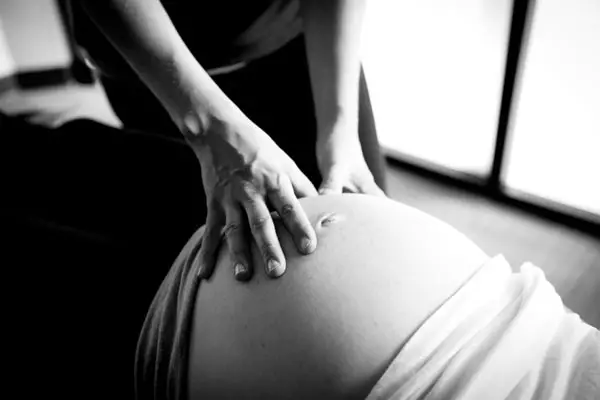
When you become pregnant, you may start to notice that you’re experiencing many more sleep disturbances, such as heartburn, snoring, leg cramps, and nausea.
Plus, if you already had bad sleep habits before you became pregnant, you will likely notice that pregnancy just compounds them. Here are a few tips to help you get a better night’s sleep.
Watch What You’re Eating
Cut back on caffeine: while you’re pregnant, you should have no more than 200 milligrams of caffeine per day, which is a typical cup of coffee.
However, it wouldn’t hurt to just cut back on caffeine even if you’re not pregnant. Also, avoid them entirely in the afternoons and evenings.
Drink less in afternoons and evenings: you should be drinking plenty of water, but try to do the majority of it early in the day instead of in the late afternoons and evenings. This will cut back on waking up to go to the bathroom in the middle of the night.
Avoid heavy and spicy meals before bedtime: spicy foods can result in indigestion and heartburn- so can big meals.
Therefore, you should avoid eating either late in the evenings before heading off to bed. The best thing is to allow yourself two to three hours to digest your meals before lying down.
Have a light snack to prevent morning sickness: if morning sickness is a problem, it could be helpful to nibble on some bland crackers or something before going to bed to prevent your stomach from being empty.
Learn Ways to Relax
Try taking naps: a quick 30 minute to one hour nap during the day will sharpen your memory, make you more alert and reduce your feelings of fatigue.
One study revealed that over half of all pregnant women do take at least one nap during the week and sixty percent take at least one on the weekends.
However, make sure that you time your naps very carefully- don’t nap too late in the afternoon/evening.
Workout earlier in the day: if you’re working out, and it’s a great idea, you should make sure that you’re exercising early enough to allow your body the time it needs to wind down.
If you work out too close to bedtime, you will likely be revved up and cause interruptions in your sleep cycle. You should try to complete your work out three or four hours before going to bed.
Practice techniques to relax: find out more information on relaxation techniques such as deep breathing, progressive muscle relaxation, and guided imagery. These can be great for helping you to decompress.
Don’t let that “worry list” get to you: try keeping a pen and paper next to the bed so that you can jot down worries when they come to mind instead of tossing and turning and thinking about it.
If writing down thoughts makes you worry more, try to write them out at least one hour before going to bed and put it out of your mind until you wake up.
Take a class: if you’re worried about labor and delivery, taking care of your new baby, or even breastfeeding, talk to your physician or midwife about taking some classes.
These will help you to know what you can expect and put your mind at ease. In addition, you will enjoy meeting others who are in the same shoes.

Practice Good Sleep Hygiene
Create (and stick to) a sleep schedule: you should try to get your body regulated to a specific sleep/wake schedule. Go to bed and get up at the same time (or as close to it as possible) every night/morning.
Create a regular, relaxing routine: you should take the time and effort to create a bedtime ritual that is soothing. This can be taking the time to read a little or even take a bath.
This should be done twenty to thirty minutes before you turn off the light. Eventually, your body will associate these actions with going to sleep and you won’t have a problem.
Create a sleep sanctuary: chances are you’re going to feel much warmer when you’re pregnant- so it’s best to keep your room a little on the cooler side.
Plus, you want to block out light and noise as much as possible, as they can jar you out of your sleep.
Only use your bed for sex and sleep: if you do things like work, watch television, or pay bills while sitting in bed, you should stop.
The bed should only be used for activities such as light reading (as in just before falling asleep), sleep, and sex.
Sleep on your left: this position will allow the nutrients and blood flow to your uterus and baby, and will help your body eliminate fluids and waste.
Making the effort to get used to this early in pregnancy (or even before, if possible) will help you to get a better sleep when your belly gets bigger- more on sleep positions in pregnancy later.
What if You Can’t Sleep?
If you just can’t sleep, you should do the following:
- Get up: if, after 20 to 30 minutes of fighting, you’re still unable to fall asleep, get out of bed and go to a different room. Listen to some relaxing music or thumb through a magazine. Once you start feeling drowsy, get up and go back to bed.
- Stop worrying about it: if you do have trouble sleeping at night, it’s nothing serious to worry about. It is a perfectly natural part of being pregnant.
- Consider chiropractic care: sometimes, the discomforts of pregnancy and changes in your body make it impossible to sleep- chiropractic care can help.
Sleeping Positions During Pregnancy
When you’ve got a baby growing in your womb, chances are you may find yourself tossing and turning- trying to find a comfortable position before falling asleep.
However, keep in mind that in some cases, your regular sleeping positions won’t work anymore. There are lots of reasons for the discomfort that you experience while you’re pregnant- but there is good news.
You can follow the above tips to ensure good sleep habits, and you can try to use some of the following sleep positions.
Since your body is going through so many different changes as your baby grows and develops, your typical peaceful slumber will be disrupted. Some of the reasons for this discomfort include the following:
- Back pain
- Shortness of breath
- Insomnia
- Heartburn
- Increased size of the abdomen
However, there are some sleep positions that can help you combat some of these problems.
The very best position for sleeping when pregnant is what is known as SOS- or, sleep on the side.
It’s best to sleep on your left side because that increases the number of nutrients and blood that are able to reach your baby and the placenta. You should keep your legs and knees bent and keep a pillow between your legs.
If you are having lots of back pain, you can sleep on your left side as instructed above, but also place a pillow under your abdomen. If you are having heartburn, try to prop your upper body with pillows.
Many times, in late pregnancy, moms-to-be will experience shortness of breath. If you are struggling with this, try to lie on your side or prop yourself up with pillows.
Of course, sleeping on your side may not sound exactly comfortable- especially if you’re one that typically sleeps on your stomach or back- but give them a chance. You might actually find that they really do work.
Also, you must keep in mind that you’re not likely to stay in one position all night long, and rotating positions is perfectly fine.
Sleep Positions to Avoid While Pregnant
Just as there are some positions that will help you sleep better, there are also some sleep positions that should be avoided as much as possible. They are as follows:
Sleeping on back: due to the enlargement of your abdomen, sleeping on your back can result in backaches, problems with your digestive system, difficulty breathing, low blood pressure, hemorrhoids and a decrease in circulation to your baby and your heart.
This is due to the fact that your abdomen is resting on major blood vessels- the aorta and vena cava- and your intestines.
Sleeping on the stomach: as you progress further into your pregnancy, your body will be going through some physical changes that will make it quite difficult for you to lie on your stomach.
Chiropractic Care During Pregnancy
Before you became pregnant, you were under the care of a chiropractor. You were able to help control your headaches, backaches, and other aches and pains. You were feeling healthier overall.
Now that you’re pregnant, can chiropractic care continue? Some people say yes and some people say no.
Safety and Benefits of Chiropractic Care During Pregnancy
If you’ve already been going to a chiropractor, you already know- but in case you haven’t, you should know that chiropractic care is the maintenance of the spinal column, bone geometry, nerves, and discs without the utilization of surgery or drugs.
It is the art and science of adjusting the joints in the body that have become misaligned, especially the spine. This adjustment reduces the stress of the spinal nerve and promotes overall health throughout the body.
Is it Safe to See a Chiropractor During Pregnancy?
According to the healthcare community, there are no known contraindications to chiropractic care during pregnancy. All chiropractors have been trained to work with women who are pregnant.
In fact, fertility and wellness during pregnancy of women who are trying to conceive or who are already pregnant are typically routine care for most chiropractors.
Keep in mind that there are some chiropractors that do take a specific interest in prenatal and even postnatal care and do have additional training above and beyond.
Following are some of the designations of chiropractors that have additional training in working with those struggling with infertility and the wellness of pregnant women.
- DACCP
- CACCP
- Member of ICPA
- Webster Certified
A chiropractor that has been trained to work with women who are expecting will typically use specialized tables that will adjust to her body and will also use some specific techniques that keep any unneeded pressure off of the abdomen.
In addition, chiropractors trained in the specialized needs of pregnant women will provide you with some stretches and exercises that you can do on your own and are safe to use during your pregnancy.

Why Use Chiropractic Care During Pregnancy?
When you are pregnant, your body will be going through many endocrinological and physiological changes that are preparing the environment for your baby as he or she develops.
Some of the following changes can cause your spine and joints to become misaligned, which leads to pain, discomfort, and even insomnia.
- Protruding abdomen
- Increasing spinal curve
- Postural adaptations
- Pelvic changes
When you use chiropractic care to ensure overall health, you can ease some of the discomforts that you experience. In addition, chiropractic care will establish balance and alignment of your pelvis, which will make your labor experience better.
After all, if your pelvis out of alignment, it can be quite difficult for the baby to get into the proper position for delivery.
In addition, if your pelvis is out of alignment, the amount of room available for your baby as he or she develops is decreased. This is known as intrauterine constraint.
When your body is out of alignment, it can affect your ability to have a non-invasive, natural birth. Posterior positions and breech positions can cause interference with the ease of natural labor and can cause you to require interventions such as a C-section.
Your nervous system is the master system in your body. It coordinates all of the communications between areas of your body and keeping it in alignment can help your body to work much more effectively.
Benefits of Chiropractic Care During Pregnancy
As you see, chiropractic care is safe- and even recommended- during pregnancy. In addition, it offers lots of benefits for women who are pregnant, such as:
- Helps you to maintain a much healthier pregnancy
- Helps you to control nausea and other symptoms of morning sickness
- Helps you reduce labor and delivery time
- Helps to relieve your joint, neck, or back pain
- Helps you to prevent a C-section
Chiropractic Care and Breech Deliveries
A specific chiropractic analysis and adjustment were developed by Larry Webster, D.C., the Founder of the International Chiropractic Pediatric Association, or ICPA.
This analysis and adjustment help to establish the balance of a pregnant woman’s pelvis and reduces the unnecessary stress on her supporting ligaments and uterus.
This balances state has been proven to allow for optimal positioning of the fetus. This technique is referred to as the Webster Technique.
Keep in mind that it is normal for some babies to present as breech until the third trimester of your pregnancy.
Most of the time, medical professionals are not worried about this breech presentation until the mother is about thirty-seven weeks.
It has been said that approximately 4 percent of all pregnancies end up in a breech presentation.
According to the Journal of Manipulative and Physiological Therapeutics, there is an 82 percent success rate of babies turning around when the mother receives chiropractic care that uses the Webster Technique.
In addition, the study suggests that it could be beneficial to use the Webster Technique as early as the eighth month of pregnancy if a baby is presenting a breech position.
At this time, the International Chiropractic Pediatric Association is recommending that women who are pregnant be under the care of a chiropractor throughout their pregnancy.
This will result in establishing the balance of the pelvis and will optimize the room that a baby has to grow and develop.
After all, when your pelvis is balanced, there is a much greater chance that your baby will move into the proper position for birth when it’s time and the worry and crisis associated with posterior positions or breech positions is reduced, if not completely avoided.
In addition, the ICPA says that optimal positioning of the baby at the time of the birth will eliminate the potential of experiencing difficult labor, which means that chiropractic care can result in a much safer and easier delivery for both mom and baby.
As the interest in chiropractic care during pregnancy is increasing, more physicians and midwives are looking to find trained chiropractic professionals in their communities to refer their pregnant patients to.
If chiropractic care during your pregnancy is something you’re interested in, discuss it with your physician and/or midwife.
If they are not familiar with the benefits of chiropractic care during pregnancy, ask them to research it.
The best thing you can do during your pregnancy is to seek out options that are supportive of your body’s natural ability to function and to look for a team of healthcare providers that are respectful and supportive of your decisions.
Sources:
http://www.babycenter.com/0_the-basics-of-good-sleep-during-pregnancy_7820.bc

A lot of great information in this post. I’ve never experienced the heartburn, but had plenty of leg cramps and morning sickness! For leg cramps I’ve learners a little trick to stop them. It’s simple but hard at the same time. Just simply point your toe. That’s it…it’s going to feelike your fighting against the cramp so it’s a little difficult but keep it pointed for a little bit and slowly release. It works wonders!! Oh and plenty of crackers for the morning sickness! 🙂
I’m a side sleeper but when I was pregnant, I was so uncomfortable sleeping on my side. What worked for me, was placing a pillow along my side. It doesn’t seem like much, but it worked wonders!
Nice — I hadn’t thought much about chiropractic care as a way to alleviate pregnancy symptoms. I like the idea of using a chiropractor as a natural way to approach spine and joint pain.